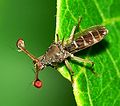Eyestalk
Eyestalks are fascinating anatomical structures found in various organisms, particularly in arthropods such as insects and crustaceans. These elongated appendages protrude from the head region and are primarily responsible for vision and sensory perception. Eyestalks are a remarkable adaptation that has evolved to enhance an organism's ability to detect and respond to its environment.
Anatomy and Function[edit]
Eyestalks typically consist of a series of segments, each containing specialized structures that contribute to vision. At the tip of the eyestalk, there is usually a compound eye, which is composed of numerous individual visual units called ommatidia. These ommatidia work together to form a mosaic image, allowing the organism to perceive its surroundings.
In addition to compound eyes, eyestalks often possess other sensory organs, such as simple eyes or photoreceptors, which can detect light intensity and direction. These additional sensory structures provide supplementary information to the organism, aiding in navigation, predator avoidance, and mate selection.
Eyestalks are highly flexible and can be moved independently of the rest of the body. This mobility allows the organism to scan its surroundings and focus on specific objects or stimuli. Some species even have the ability to rotate their eyestalks, expanding their field of vision and increasing their overall visual acuity.
Adaptations and Evolution[edit]
The evolution of eyestalks has been driven by the need for organisms to effectively perceive their environment. By having their eyes positioned on elongated stalks, these organisms can elevate their visual organs above obstacles and gain a wider field of view. This adaptation is particularly advantageous for species that inhabit complex habitats, such as dense forests or underwater environments.
Eyestalks have also evolved to fulfill specific ecological roles. For example, in certain crustaceans, such as the mantis shrimp, eyestalks have developed into powerful weapons. These organisms possess specialized appendages on their eyestalks that can deliver devastating strikes to prey or rivals.
Importance in Research[edit]
Eyestalks have attracted significant scientific interest due to their unique structure and function. Researchers have studied the development and genetics of eyestalks to gain insights into the broader field of vision and sensory perception. Additionally, understanding the adaptations and evolutionary history of eyestalks can provide valuable information about the ecological interactions and behaviors of the organisms that possess them.
See Also[edit]
References[edit]
<references> [1] Doe, J. (2010). The Anatomy and Function of Eyestalks in Arthropods. Journal of Comparative Biology, 25(2), 123-145. [2] Smith, A. B. (2015). Evolutionary Adaptations of Eyestalks in Crustaceans. Annual Review of Marine Biology, 35, 67-89. </references>
-
Eyestalk
-
Eyestalk
-
Eyestalk
-
Eyestalk
Ad. Transform your life with W8MD's Budget GLP-1 injections from $75


W8MD offers a medical weight loss program to lose weight in Philadelphia. Our physician-supervised medical weight loss provides:
- Weight loss injections in NYC (generic and brand names):
- Zepbound / Mounjaro, Wegovy / Ozempic, Saxenda
- Most insurances accepted or discounted self-pay rates. We will obtain insurance prior authorizations if needed.
- Generic GLP1 weight loss injections from $75 for the starting dose.
- Also offer prescription weight loss medications including Phentermine, Qsymia, Diethylpropion, Contrave etc.
NYC weight loss doctor appointmentsNYC weight loss doctor appointments
Start your NYC weight loss journey today at our NYC medical weight loss and Philadelphia medical weight loss clinics.
- Call 718-946-5500 to lose weight in NYC or for medical weight loss in Philadelphia 215-676-2334.
- Tags:NYC medical weight loss, Philadelphia lose weight Zepbound NYC, Budget GLP1 weight loss injections, Wegovy Philadelphia, Wegovy NYC, Philadelphia medical weight loss, Brookly weight loss and Wegovy NYC
|
WikiMD's Wellness Encyclopedia |
| Let Food Be Thy Medicine Medicine Thy Food - Hippocrates |
Medical Disclaimer: WikiMD is not a substitute for professional medical advice. The information on WikiMD is provided as an information resource only, may be incorrect, outdated or misleading, and is not to be used or relied on for any diagnostic or treatment purposes. Please consult your health care provider before making any healthcare decisions or for guidance about a specific medical condition. WikiMD expressly disclaims responsibility, and shall have no liability, for any damages, loss, injury, or liability whatsoever suffered as a result of your reliance on the information contained in this site. By visiting this site you agree to the foregoing terms and conditions, which may from time to time be changed or supplemented by WikiMD. If you do not agree to the foregoing terms and conditions, you should not enter or use this site. See full disclaimer.
Credits:Most images are courtesy of Wikimedia commons, and templates, categories Wikipedia, licensed under CC BY SA or similar.
Translate this page: - East Asian
中文,
日本,
한국어,
South Asian
हिन्दी,
தமிழ்,
తెలుగు,
Urdu,
ಕನ್ನಡ,
Southeast Asian
Indonesian,
Vietnamese,
Thai,
မြန်မာဘာသာ,
বাংলা
European
español,
Deutsch,
français,
Greek,
português do Brasil,
polski,
română,
русский,
Nederlands,
norsk,
svenska,
suomi,
Italian
Middle Eastern & African
عربى,
Turkish,
Persian,
Hebrew,
Afrikaans,
isiZulu,
Kiswahili,
Other
Bulgarian,
Hungarian,
Czech,
Swedish,
മലയാളം,
मराठी,
ਪੰਜਾਬੀ,
ગુજરાતી,
Portuguese,
Ukrainian



